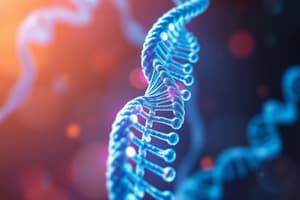Podcast
Questions and Answers
What is the primary function of the lac operon in E. coli?
What is the primary function of the lac operon in E. coli?
- To break down lactose into simpler sugars (correct)
- To produce cAMP in the presence of glucose
- To synthesize lactose from simpler sugars
- To metabolize glucose as an energy source
What is the role of the lac repressor in the lac operon?
What is the role of the lac repressor in the lac operon?
- To transport lactose into the cell
- To break down lactose into simpler sugars
- To bind to the operator region and prevent transcription of the lac operon genes (correct)
- To activate transcription of the lac operon genes
What is the effect of glucose on the lac operon?
What is the effect of glucose on the lac operon?
- It inhibits transcription of the lac operon genes (correct)
- It has no effect on the lac operon
- It activates transcription of the lac operon genes
- It increases cAMP production
What is the role of the CAP protein in the lac operon?
What is the role of the CAP protein in the lac operon?
What is the function of the Lac Z gene?
What is the function of the Lac Z gene?
What is the effect of allolactose on the lac repressor?
What is the effect of allolactose on the lac repressor?
What is the significance of the equal number of purines and pyrimidines in DNA?
What is the significance of the equal number of purines and pyrimidines in DNA?
What is the role of X-ray crystallography in determining DNA's structure?
What is the role of X-ray crystallography in determining DNA's structure?
What is the nature of the sugar-phosphate backbone in DNA?
What is the nature of the sugar-phosphate backbone in DNA?
What is the result of the hydrophobic interactions between DNA strands?
What is the result of the hydrophobic interactions between DNA strands?
What is the significance of the antiparallel nature of DNA strands?
What is the significance of the antiparallel nature of DNA strands?
What is the result of the polymerization of activated nucleotides?
What is the result of the polymerization of activated nucleotides?
In which direction do phosphodiester linkages form a sugar-phosphate backbone in DNA and RNA strands?
In which direction do phosphodiester linkages form a sugar-phosphate backbone in DNA and RNA strands?
What type of reaction is involved in the polymerization of nucleotides to form nucleic acids?
What type of reaction is involved in the polymerization of nucleotides to form nucleic acids?
What is the bond that occurs between the phosphate group on the 5' carbon of one nucleotide and the group on the 3' carbon of another nucleotide?
What is the bond that occurs between the phosphate group on the 5' carbon of one nucleotide and the group on the 3' carbon of another nucleotide?
What is the primary structure of DNA written by listing?
What is the primary structure of DNA written by listing?
What is the result of the polymerization of ribonucleotides?
What is the result of the polymerization of ribonucleotides?
What is the backbone of nucleic acids composed of?
What is the backbone of nucleic acids composed of?
What is the primary purpose of the hydrogen bonds broken during the first step of DNA replication?
What is the primary purpose of the hydrogen bonds broken during the first step of DNA replication?
What is the role of the sugar-phosphate backbone in the structure of DNA?
What is the role of the sugar-phosphate backbone in the structure of DNA?
What is the significance of the antiparallel nature of the strands in a DNA molecule?
What is the significance of the antiparallel nature of the strands in a DNA molecule?
What is the primary difference between the primary structure of RNA and DNA?
What is the primary difference between the primary structure of RNA and DNA?
What is the significance of the 2′ group on the ribose molecule in RNA?
What is the significance of the 2′ group on the ribose molecule in RNA?
What is the result of the complementary base pairing during DNA replication?
What is the result of the complementary base pairing during DNA replication?
Flashcards are hidden until you start studying
Study Notes
Lac Operon
- The lac operon is a part of the E. coli genome and is complex
- It is responsible for lactose metabolism and contains genes that code for enzymes involved in lactose breakdown
- The lac operon is induced by the presence of lactose
Lac Z, Lac Y, and Lac A Genes
- Lac Z gene codes for an enzyme that breaks down lactose into simpler sugars
- Lac Y gene codes for an enzyme that helps transport lactose into the cell
- Lac A gene is not as well understood, but is also involved in lactose metabolism
Lac Repressor and Operator
- The lac repressor binds to the operator region, preventing transcription of the lac operon genes
- Allolactose, a lactose isomer, can bind to the lac repressor, releasing it from the operator and allowing transcription to occur
Glucose and Lactose Metabolism
- Glucose is preferred over lactose as an energy source
- In the presence of glucose, the lac operon genes are not transcribed
- When glucose is absent, the lac operon genes are transcribed, allowing for lactose metabolism
Catabolite Activator Protein (CAP) and cAMP
- CAP is a protein that, when bound to cAMP, activates transcription of the lac operon genes
- cAMP is produced in low glucose conditions, allowing for CAP activation and lac operon transcription
- When glucose is present, cAMP production is inhibited, preventing CAP activation and lac operon transcription
Regulation of Lac Operon
- The lac operon is regulated by a complex interplay of glucose and lactose availability, as well as the presence of Allolactose and the lac repressor
- The lac operon is induced in the presence of lactose and low glucose conditions, and is repressed in the presence of glucose.
Lac Operon
- The lac operon is a part of the E. coli genome responsible for lactose metabolism.
- It contains genes that code for enzymes involved in lactose breakdown.
Lac Z, Lac Y, and Lac A Genes
- Lac Z gene codes for an enzyme that breaks down lactose into simpler sugars.
- Lac Y gene codes for an enzyme that helps transport lactose into the cell.
- Lac A gene is involved in lactose metabolism, although its exact function is not well understood.
Lac Repressor and Operator
- The lac repressor binds to the operator region, preventing transcription of the lac operon genes.
- Allolactose, a lactose isomer, can bind to the lac repressor, releasing it from the operator and allowing transcription to occur.
Glucose and Lactose Metabolism
- Glucose is preferred over lactose as an energy source.
- In the presence of glucose, the lac operon genes are not transcribed.
- When glucose is absent, the lac operon genes are transcribed, allowing for lactose metabolism.
Catabolite Activator Protein (CAP) and cAMP
- CAP is a protein that, when bound to cAMP, activates transcription of the lac operon genes.
- cAMP is produced in low glucose conditions, allowing for CAP activation and lac operon transcription.
- When glucose is present, cAMP production is inhibited, preventing CAP activation and lac operon transcription.
Regulation of Lac Operon
- The lac operon is regulated by a complex interplay of glucose and lactose availability, as well as the presence of Allolactose and the lac repressor.
- The lac operon is induced in the presence of lactose and low glucose conditions, and is repressed in the presence of glucose.
Studying That Suits You
Use AI to generate personalized quizzes and flashcards to suit your learning preferences.




